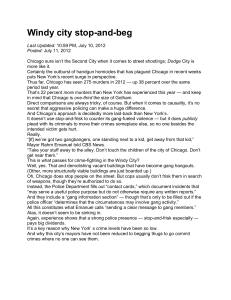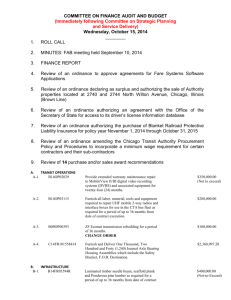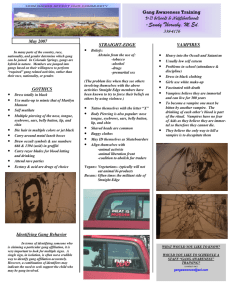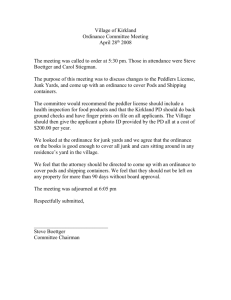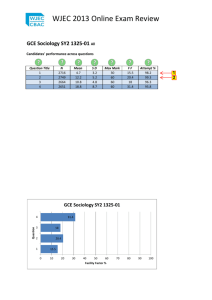Lesson 5: Policymaking in the Three Branches of Government
advertisement
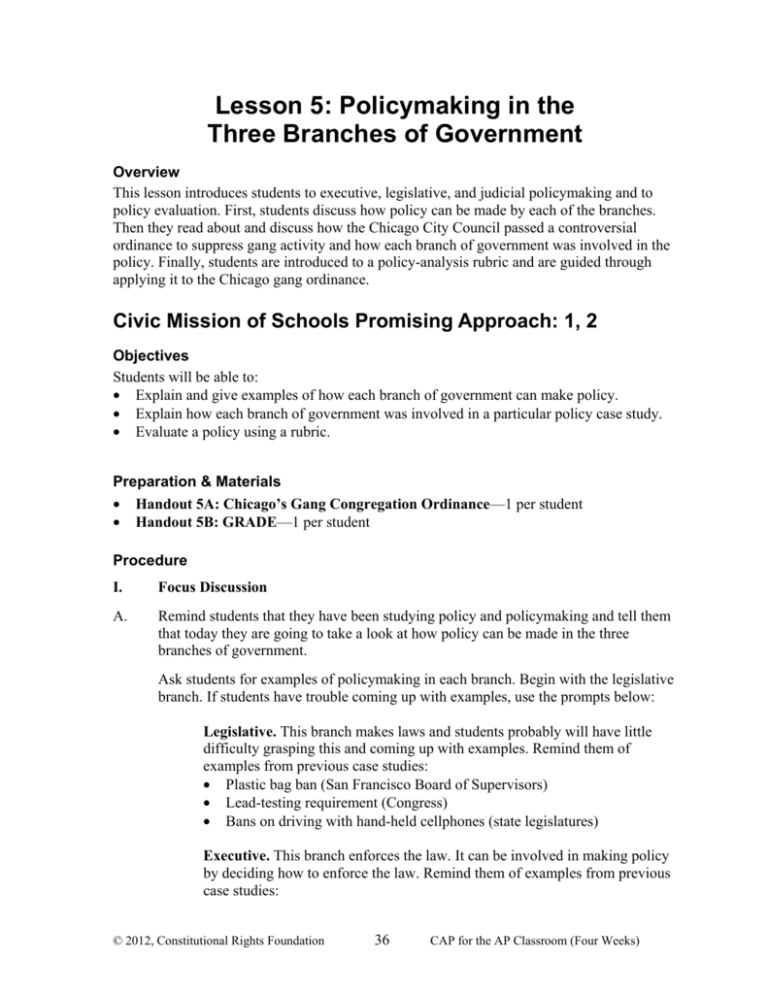
Lesson 5: Policymaking in the Three Branches of Government Overview This lesson introduces students to executive, legislative, and judicial policymaking and to policy evaluation. First, students discuss how policy can be made by each of the branches. Then they read about and discuss how the Chicago City Council passed a controversial ordinance to suppress gang activity and how each branch of government was involved in the policy. Finally, students are introduced to a policy-analysis rubric and are guided through applying it to the Chicago gang ordinance. Civic Mission of Schools Promising Approach: 1, 2 Objectives Students will be able to: • Explain and give examples of how each branch of government can make policy. • Explain how each branch of government was involved in a particular policy case study. • Evaluate a policy using a rubric. Preparation & Materials • Handout 5A: Chicago’s Gang Congregation Ordinance—1 per student • Handout 5B: GRADE—1 per student Procedure I. Focus Discussion A. Remind students that they have been studying policy and policymaking and tell them that today they are going to take a look at how policy can be made in the three branches of government. Ask students for examples of policymaking in each branch. Begin with the legislative branch. If students have trouble coming up with examples, use the prompts below: Legislative. This branch makes laws and students probably will have little difficulty grasping this and coming up with examples. Remind them of examples from previous case studies: • Plastic bag ban (San Francisco Board of Supervisors) • Lead-testing requirement (Congress) • Bans on driving with hand-held cellphones (state legislatures) Executive. This branch enforces the law. It can be involved in making policy by deciding how to enforce the law. Remind them of examples from previous case studies: © 2012, Constitutional Rights Foundation 36 CAP for the AP Classroom (Four Weeks) • • The executive was involved in the three legislative examples above because the executive signed them into law. Suicide barriers on bridge (Caltrans—Department of Transportation in the executive branch of California) Judicial. This branch interprets the law. Clearly, this branch affects policy as students have seen in the random drug testing case study (which the Supreme Court ruled constitutional). But this branch also makes policy (judicial policymaking is often controversial). Consider these examples: • A Colorado judge has a sentencing policy for young people convicted of playing their music too loud while driving around the city. Instead of imposing a fine, he sentences them to one hour of listening to his music. He claims to no longer see repeat offenders. • The Miranda rule was created by the Supreme Court in a confession case. The rule sets forth requirements that police must follow before questioning a criminal suspect. It is a policy to make sure police comply with the Fifth Amendment. B. Tell students that they are going to examine a case study showing how all three branches of government can be involved in policymaking. II. Reading and Discussion—Chicago’s Gang Congregation Ordinance A. Distribute Handout 5A: Chicago’s Gang Congregation Ordinance to each student. Tell students that this handout tells the story of an attempt by the city of Chicago to put a new gang suppression policy into place. Ask them to read it and look for the actions taken on the policy by the legislative, executive, and judicial branches. B. When students finish reading, hold a discussion using the questions on the handout: 1. What problem(s) was the policy designed to address? • Violent crimes, vandalism • Fearful residents • Gangs 2. How was the legislative branch involved with the policy? Name the actions and what legislative body did them. • Public hearings on gangs (City Council’s Committee on Fire and Police) • Passed the Gang Congregation Ordinance (City Council) 3. How was the executive branch involved? Name the actions and what executive body did them. • Signed Gang Congregation Ordinance into law (Mayor) • Issued General Order 92-4 (Chicago Police Department) • Issued dispersal orders (Chicago Police Department) • Arrested people for violating the ordinance (Chicago Police Department) • Put those arrested on trial (Prosecutors) • Handled appeals (Prosecutors) © 2012, Constitutional Rights Foundation 37 CAP for the AP Classroom (Four Weeks) 4. How was the judicial branch involved? Name the actions and what judicial body did them. • Tried the defendants (State Trial Courts) • Heard appeals (Illinois Appellate Court, Illinois Supreme Court, and U.S. Supreme Court) • Ruled on the ordinance’s constitutionality (All of the courts mentioned above) III. Guided Activity—GRADE A. Explain that analyzing policy is important: It is important to policymakers deciding what to do about a problem and when deciding whether to change a policy. Analyzing policy is also important to citizens. Voters may be asked to vote on policy initiatives. Politicians may promise to enact certain policies, and citizens may need to analyze what the politicians are proposing. Citizens in a democracy can influence policy, and it’s important to have the tools to analyze it. B. Tell students that they are going to practice analyzing policy by evaluating the Chicago Gang Congregation Ordinance using a policy-analysis tool. Distribute Handout 5B: GRADE to each student. Review the handout and then, calling on students, begin using GRADE to analyze the ordinance. Below are some possible responses: G — The goal of the policy is to stop gang members from hanging around neighborhoods and intimidating people. R — The reading does not specifically mention supporters or opponents. It’s important that students begin thinking about who might support and oppose particular policies. Ask students to think of who might support or oppose the policy. Below are a few possibilities: Possible Supporters police neighborhood associations local politicians prosecutors people terrorized by gangs Possible Opponents gang members minority-group organizations civil-liberty organizations non-profits supporting the homeless defense attorneys A — Among the advantages: • Police can break up groups even when they are doing nothing wrong and thus rid neighborhoods of gang members. • People will not be intimidated by gang members hanging around the neighborhood. © 2012, Constitutional Rights Foundation 38 CAP for the AP Classroom (Four Weeks) D — Among the disadvantages: • Police may arrest people who are doing nothing wrong and are not even gang members. • The law violates peoples’ basic liberties. E — Ask students to weigh the advantages against the disadvantages. If they believe the advantages outweigh the disadvantages, then they favor the policy, but they must also consider alternatives. Tell them that one alternative is always to do nothing. Ask them if they know of any other alternatives. If they do, briefly discuss them. IV. Debrief A. Ask students: B. • Can you think of other examples of policymaking in different branches of government? (national and local) • Why should citizens know about policymaking in the three branches of government? Think of when knowing which branch might be associated with a particular policy would come in handy. After completing this lesson, have students return to the Citizenship Brainstorm, identifying and adding to the lists. © 2012, Constitutional Rights Foundation 39 CAP for the AP Classroom (Four Weeks) Handout 5A Chicago’s Gang Congregation Ordinance In the United States, particularly in urban areas, criminal street gangs pose great danger. They often try to take over parts of a city, battling other gangs in turf wars and terrorizing residents. Like other cities, Chicago has had much experience with gangs. In the 1990s, more than 100 criminal gangs roamed its streets. In an eight-year period, Chicago street gangs committed more than 60,000 crimes, including 20,000 violent crimes and 894 homicides. In 1992, the Chicago City Council’s Committee on Fire and Police conducted public hearings on the city’s street gangs. Many testified about the terror they felt on city streets. One woman stated: “When I walk out my door, these guys are out there . . . . They watch you . . . . They know where you live. They know what time you leave, what time you come home. I am afraid of them.” Another resident said: “I have never had the terror that I feel every day when I walk down the streets of Chicago. . . . I have had my windows broken out. I have had guns pulled on me. I have been threatened. I get intimidated on a daily basis. . . .” From these hearings, the City Council concluded “criminal street gangs establish control over identifiable areas . . . by loitering in those areas and intimidating others from entering those areas.” It found that the “burgeoning presence of street gang members in public places has intimidated many law abiding citizens” and “creates a justifiable fear for the safety of persons and property in the area.” In response, in June 1992, the City Council passed the Gang Congregation Ordinance, and the mayor signed it into law. To violate this law, four things must happen. First, a police officer must reasonably believe that a street gang member is present in a group of two or more. Second, the people must be “loitering,” which the law defines as staying “in any one place with no apparent purpose.” Third, the officer must issue an order for the group to disperse. Fourth, the people must disobey the order. If convicted, an offender could face up to six months in jail, a fine up to $500, and up to 120 hours of community service. Within two months of the ordinance’s passage, the Chicago Police Department issued General Order 92-4, containing guidelines on how it was going to enforce the law. The purpose of the guidelines was “to ensure that the anti-gang loitering ordinance is not enforced in an arbitrary or discriminatory way.” The guidelines limited enforcement to “designated areas,” not made public. They further allowed only officers in the Gang Crime Section and other specific officers to make arrests under the ordinance. They also spelled out criteria for identifying gang members. The ordinance was in effect from August 1992 to December 1995. During that period, police issued almost 90,000 dispersal orders and arrested more than 40,000 people for violating the law. Many of these people were put on trial. Thirteen trials were held. In each, lawyers for the defendants challenged the constitutionality of the ordinance. Eleven judges ruled that the ordinance was unconstitutional, and the prosecutors appealed. Two trial judges, however, © 2012, Constitutional Rights Foundation 40 CAP for the AP Classroom (Four Weeks) upheld the law, and the ensuing trials convicted some defendants. These defendants appealed their convictions. The Illinois Appellate Court consolidated all the appeals and ruled that the ordinance was unconstitutional. This occurred in December 1995, and police stopped enforcing the ordinance. The prosecutors appealed to the Illinois Supreme Court. This court also ruled that the law was unconstitutional. The prosecutors appealed to the U.S. Supreme Court. The U.S. Supreme Court granted certiorari, meaning it decided to hear the case. In 1999, the court issued its opinion in City of Chicago v. Morales. (Jesus Morales was one of the defendants in the case. The name of the party appealing the case is always listed first.) The court found Chicago’s Gang Congregation Ordinance unconstitutional. It ruled that the law violated the 14th Amendment’s due process clause, which, among other things, requires fair notice. The court said that the meaning of staying “in any one place with no apparent purpose” was unclear. “[T]he purpose of the fair notice requirement is to enable the ordinary citizen to conform his or her conduct to the law. . . . Although it is true that a loiterer is not subject to criminal sanctions unless he or she disobeys a dispersal order, the loitering is the conduct that the ordinance is designed to prohibit. If the loitering is in fact harmless and innocent, the dispersal order itself is an unjustified impairment of liberty.” Excerpts From the Chicago Gang Congregation Ordinance (a) (b) (c) (e) Whenever a police officer observes a person whom he reasonably believes to be a criminal street gang member loitering in any public place with one or more other persons, he shall order all such persons to disperse and remove themselves from the area. Any person who does not promptly obey such an order is in violation of this section. It shall be an affirmative defense to an alleged violation of this section that no person who was observed loitering was in fact a member of a criminal street gang. As used in this section: (1) “Loiter” means to remain in any one place with no apparent purpose. . . . ... (5) “Public place” means the public way and any other location open to the public, whether publicly or privately owned. . . . ... Any person who violates this section is subject to a fine of not less than $100 and not more than $500 for each offense, or imprisonment for not more than six months, or both. In addition . . . , any person who violates this section may be required to perform up to 120 hours of community service . . . . © 2012, Constitutional Rights Foundation 41 CAP for the AP Classroom (Four Weeks) For Discussion 1. How was the legislative branch involved with the policy? List the actions and what legislative body did them. 2. How was the executive branch involved? List the actions what executive body did them. 3. How was the judicial branch involved? List the actions and what judicial body did them. © 2012, Constitutional Rights Foundation 42 CAP for the AP Classroom (Four Weeks) Handout 5B GRADE As citizens in a democracy, you’ll be confronted with policy questions. Is a tax proposal a good idea? Should you vote for a particular ballot initiative? Government policies can profoundly affect our nation and your life. In a democracy, you have a say on government policies and proposed policies. It’s important that you take a critical look at them. Use the following GRADE tests to evaluate a policy: G R A D E oal. What is the goal of the policy? If you don’t know what it’s supposed to do, you can’t measure its success or failure. Policies are designed to address problems. What problem or problems is this policy supposed to address? ivals. Who might (or does) support the policy? Who might (or does) oppose it? Knowing the rivals can help you understand who the policy might affect and whether the policy favors special interests. Also, rivals are terrific sources for information, but you must check their facts. dvantages. What are the policy’s benefits? What is good about the policy? Does the policy address the causes or effects of the problem? Will it achieve (or has it achieved) its goal? Will it achieve the goal efficiently? Is it inexpensive? Does it protect people from harm? Does it ensure people’s liberties? isadvantages. What are the policy’s costs? What is bad about the policy? Does the policy fail to address the causes or effects of the problem? Is it inefficient? Is it expensive? Does it cause harm? Does it intrude on people’s liberties? Are there any potential consequences that may cause damage? valuate. Weigh the advantages versus the disadvantages. Are there alternative policies? One alternative is to do nothing. Most serious problems have various policy proposals. Evaluate them. Look at their goals, advantages, and disadvantages. © 2012, Constitutional Rights Foundation 43 CAP for the AP Classroom (Four Weeks) Policy Analysis Proposed Policy: Problem or Issue the policy is attempting to address: G Goal/s R Rivals A Advantages D Disadvantages E Evaluate © 2012, Constitutional Rights Foundation 44 CAP for the AP Classroom (Four Weeks)
